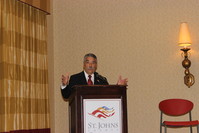






The connection of 9B to St. Johns Parkway, improvements to Race Track Road and efforts to deal with traffic and parking issues in St. Augustine were among the priorities highlighted by local, state and county transportation officials at a St. Johns County Chamber of Commerce breakfast last week.
As Florida’s population continues to increase, officials said, transportation improvements are critical to ensuring continued growth and prosperity both locally and statewide.
“By 2030, we’ll have 6 million more people calling Florida home,” CSX Vice President Quitin Kendall told attendees at the Aug. 26 breakfast presentation sponsored by the chamber’s Economic Development Council. Locally, he said, estimates predict that St. Johns County will have as many as 150,000 new residents by that time.
“For this continued growth, we’ve got to ensure Florida remains successful,” Kendall said, “and we need to plan for Florida’s future and that includes transportation.”
Both state and county officials agreed that the construction of 9B and its planned connection to St. Johns Parkway (CR 2209) are significant transportation improvements needed to keep pace with the population growth.
“We’re very excited to be able to deliver 9 B,” said Greg Evans, District 2 secretary for the Florida Department of Transportation. “I saw this magnificent highway ending pointed directly at St. Johns County and said, ‘We can’t stop there….we’ve got to get the northern part of St. Johns County connected to 95, US1 and 295 as well.”
Phong Nguyen, division director of transportation development for St. Johns County, said that connecting 9B to St. Johns Parkway will also have a significant impact, both on mobility and the regional economy.
“That will basically change the entire landscape of northern St. Johns County,” said Nguyen, noting that development projects such as Durbin National and the proposed Project Family sports complex would be located in that area. To further support residential and economic growth, he added, the county plans to make improvements to key intersections along CR 2209, and on Race Track Road.
“We have this vision of our north-south corridor to connect Race Track all the way down to CR 204,” Nguyen said. “So you can see that is a crucial element to accommodate future development growth in the area.”
“Radical” plans for St. Augustine
When it comes to addressing St. Augustine’s traffic and parking woes, City Manager John Regan said the types of major road construction projects underway in northern St. Johns County won’t work.
“We can’t build ourselves out of the issues,” he said. “In an urban core, we have to think differently and we have to fundamentally change our culture…we have to find ways to marry transportation form to urban form and find those alternate pathways of mobility.”
Accomplishing that, Regan said, will require plans to reduce the number of cars visiting the Ancient City by 30 to 40 percent.
“You can assume that at least 30 percent of traffic (in St. Augustine) is just driving around looking for parking,” said Regan, adding that the city must overhaul its parking policy and begin looking at ways to add bicycle lanes and sidewalks to make the city more pedestrian friendly.
“We need to rebuild the fundamental bones of neighborhoods,” he said. “Some of the things we’re going to be proposing are going to be counterintuitive to people initially.”
Regan pointed to plans to improve the intersection of May Street and San Marco Avenue – a known bottleneck that causes traffic to back up on the Usina Bridge – by incorporating what he called a “radical” European design that will feature a circular pattern with a road through it and two signalized intersections.
“What this does is it allows space to move people where they want to go and do it with a tremendous amount of stability,” Regan said of the proposed traffic pattern.
Related improvements to the park and library near the intersection, he added, will result in an “entry gateway of beauty” to the city.
“The top reason people choose where they live… is aesthetics,” Regan said. “This is going to continue to safeguard that aesthetic that we identify with St. Augustine.”